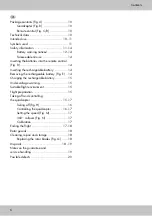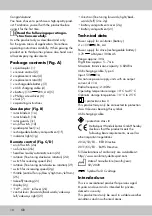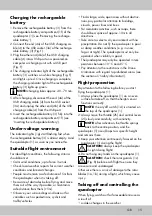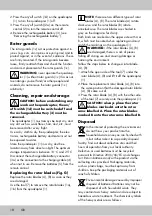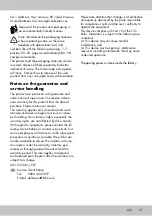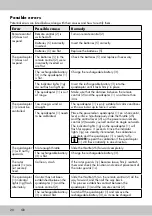
17
When headless mode is activated using button
(2c), from the pilot’s viewpoint, the quadcopter
(1) always flies to the right when the control
lever (2l) is steered to the right, regardless of
which way the front of the quadcopter (1) is
facing.
NOTE:
the direction of the remote control
(2) and the quadcopter (1) must correspond
exactly when activating headless mode!
Only activate headless mode in the position spec-
ified, otherwise it may result in control commands
not being carried out correctly.
1. To activate headless mode, put the quadcopter
(1) and the remote control (2) one behind the
other and press the button (2c) on the remote
control (2).
The ‘HEADLESS’ field lights up on the display
(2j) and the quadcopter (1) lights flash slowly
as long as the mode is activated.
2. To deactivate the mode, press the button (2c)
again. On the display (2j), ‘NORMAL’ is
illuminated and the quadcopter lights light up
continuously again.
• Automatic return to the pilot (Fig. R)
Press the active button (2c) for approx. 3 sec-
onds if the quadcopter (1) is to return to the
starting point.
NOTE:
the return route can vary as a result
of the quadcopter (1) turning. The operation
can be cancelled by pressing the button (2c)
repeatedly or by moving the control lever (2l).
Setting the speed (Fig. M)
You can adjust the flight speed by repeatedly
pressing the buttons (2e, 2g) on the remote control
(2). The default setting is speed 2, from a total of
four speed levels.
The display (2j) shows the various levels.
Speed 1 (one beep)
For first attempts with little flight experience.
Speed 2 (two beeps)
For pilots with some experience.
Speed 3 (three beeps)
For experienced pilots.
Speed 4 (four beeps)
For very experienced pilots.
NOTE:
when the remote control is turned off
and on, the quadcopter (1) is reset to speed
2.
360° rollover (Fig. N)
1. Fly the quadcopter (1) to a height of approx.
10m.
2. Keep it hovering and press the button (2k)
located at the front of the remote control once.
A signal tone is emitted and the ‘FLIP’ light is
shown on the display (2j).
3. Move the control lever (2l) in the direction in
which the rollover is to be performed.
4. The quadcopter (1) will perform a 360°
rollover.
After the rollover, the quadcopter (1) will be in
normal flight mode and you can perform another
rollover.
Repeat steps 1–4 to do so.
Press the button (2k) again if you do not want to
perform a rollover, but had already pressed the
button.
CAUTION:
you need sufficient flight
altitude for a 360° rollover (at least 10m).
Calibration
You may occasionally find that the quadcopter (1)
flies erratically and needs to be calibrated. In this
event, follow the steps below:
1. Place the powered-on quadcopter (1) on a
horizontal, level surface.
2. Simultaneously slide the throttle (2h) and the
control lever (2l) on the powered-on remote
control (2) towards yourself and at an angle
outwards. The indicator lights (1g) on the
quadcopter (1) will flash for approx. 3 seconds.
Once the indicator lights (1g) are steadily
illuminated, the calibration is complete and the
quadcopter is ready to fly.
NOTE:
repeat the calibration if the
quadcopter still flies erratically in one
direction.
Ending the flight
1. Press the ‘START/LAND’ button (2i). The quad-
copter slowly descends and lands.
After the quadcopter (1) has landed safely,
switch it off in the proper sequence.
GB




